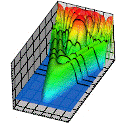Department of Physics and Astronomy: Publications and Other Research

Anthony F. Starace Publications
Document Type
Article
Date of this Version
August 1976
Abstract
The Quantum Defect Theory (QDT) is a method of using the analytically known properties of excited electrons moving in a pure Coulomb field to describe atomic photoabsorption and electron-ion scattering processes in terms of a few parameters. These parameters may be determined either from experimental data or from ab initio theoretical calculations. In addition, they are usually nearly independent of energy in the threshold energy region (i.e., within a few eV of the atomic ionization threshold). Thus the determination of these parameters at any single energy suffices to predict the variation with energy of numerous atomic properties in the threshold energy region such as total and partial photoionization or scattering cross sections, photoelectron asymmetry parameters, discrete line strengths, autoionization profiles, etc. These properties are often very strongly energy-dependent and difficult to measure or to calculate by other methods. Yet all these phenomena, according to the QDT, depend on only a few essential parameters which represent the proper interface between theory and experiment. The determination of these parameters should thus be the goal of both theory and experiment rather than the calculation or measurement of the various phenomena dependent on these parameters.
This article aims to describe the essence of the QDT for the non-specialist. More extensive surveys of the theory for the non-specialist by Seaton and Fano should be consulted for more complete references to the original literature. Here we shall first discuss the one channel theory since it embodies the main content of the general multichannel theory. Then we shall sketch the multichannel treatment of Lu and Fano and its applications.


Comments
Published in PHOTOIONIZATION AND OTHER PROBES OF MANY-ELECTRON INTERACTIONS, ed. F. J. Wuilleumier (New York: Plenum, 1976). Used by permission.